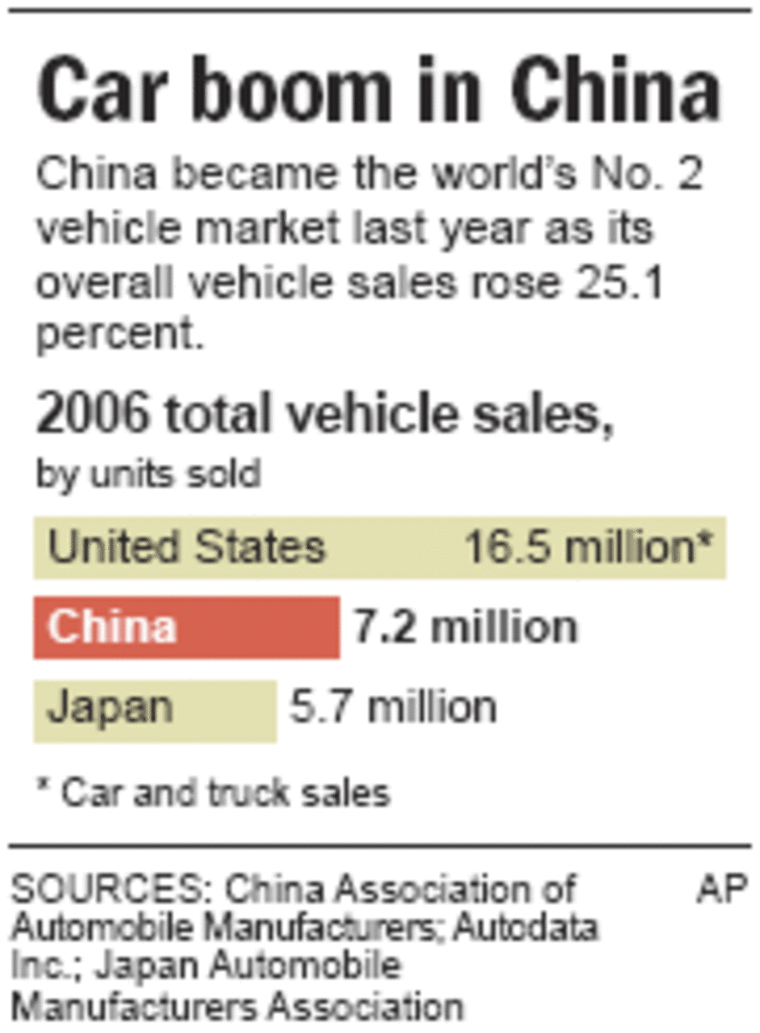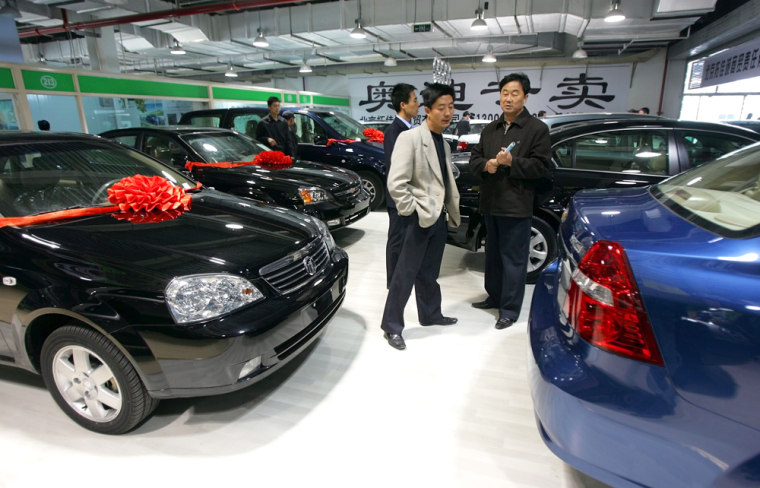Sha Heping was a proud husband on New Year’s Eve as he put down the deposit for a $15,000 subcompact with the optional sunroof, a gift for his wife who used to commute to work by bicycle every day, even in biting winter cold.
With savings from over 20 years of service as a Beijing government functionary, Sha is the latest statistic underpinning the world’s hottest market.
China sold an estimated 7 million vehicles last year, extending its lead over Japan as the world’s second-biggest auto market after the United States, and like Sha, most of the buyers were first-time car owners.
Leaps and bounds
China’s auto market has grown by leaps and bounds since it passed 1 million units a year in 2002. By 2004, it surpassed Germany as the third-biggest auto market with over 2.6 million units. It roared past Japan in 2005 in terms of domestic sales and could also displace Japan as the No. 2 volume producer by 2011, according to Global Insight, a strategic consulting company. (Japan exports nearly half its output.)
According to Chinese policy researcher Zheng Xinli, by 2020 China could well topple the United States as the world’s biggest auto market with annual output of 15 million units. By then, experts predict, China’s total car ownership could even begin to exceed that of the U.S.

Behind all this are first-time car owners like Sha, who represent a tantalizing 80 percent of China’s car buyers. That is virtually the opposite of more mature markets like the United States, Europe and Japan, where first-time car buyers have stagnated below 15 percent, according to J.D. Power.
With the rapid expansion of China’s urban middle class, analysts predict that first-time car buyers will continue to fire up China’s red-hot market, setting the stage for more massive investments and intense competition among local and foreign car manufacturers alike.
Reversal of fortunes
For America’s auto giants, struggling to reverse declining fortunes at home, China’s market has become the focus of global expansion. Led by chief executive Rick Wagoner, who predicted two years back a “great gold rush” in China, General Motors is pouring in $3 billion over three years to expand capacity, on the calculation that some 74 million Chinese families can now afford to buy cars.
GM holds the No. 1 position, with 665,390 units sold in 2005 for 11.8 percent market share, and sales grew further in 2006 to 876,747, led by its fast-selling Buick Excelle passenger car. Germany’s Volkswagen, with a decade-long head start in China, is closely catching up as market leader.
In a bold shift in strategy that will pit it head-on against upstart local manufacturers, GM has announced that more resources will be channeled to small car production, which represents China’s fastest-growing market.
“We are laying a plan to compete better at the bottom end,” declared GM’s president for Asia-Pacific operations at the November auto show in Beijing, citing GM’s spectacular success with a joint venture that has racked up six-fold growth in sales with its bare-bones minivans costing less than $6,000.
DaimlerChrysler and Ford are not yet following the rush to the low-margin segment, but nonetheless have ambitions to expand in subcompact and upmarket production. Late-comer Ford has more than doubled its sales with 129,790 units sold in 2006, sixty percent of which was accounted by its hugely popular Focus model line.
“The demand has been so strong for all our models that we have emptied our vehicle storage compounds,” said David G. Thomas, general manager of Changan Ford Mazda Automobile.
What has intrigued analysts, however, is the recent deal announced by Chrysler Group chief executive Tom LaSorda, which 75 American dealers have signed up for, to bring Chinese-made cars to the U.S. market for the first time.
Taking advantage of cheap Chinese labor and manufacturing costs, Chrysler has contracted China’s Chery Automobile Co. to build subcompact cars in China for Chrysler’s Dodge brand.
“Chery won’t create any American manufacturing sites. This time, Chrysler will serve as mere distributor. ... This looks remarkably like the Wal-Mart-ization of the U.S. auto industry,” said Tom Adkins in his column for the conservative Web site CommonConservative.com.
Chinese export potential
For some analysts, however, the Chrysler-Chery deal may well be a signal that the manufacturing of vehicles, especially for the entry-level market, is starting to shift to China, in much the same way that production of garments, shoes and TV sets did.
Chinese manufacturers, which now control some 27 percent of the domestic market, have become masters at controlling costs and holding prices down, with a typical Chinese auto worker earning $1.95 an hour against a German counterpart’s $49.50 an hour.
Government-owned Chery itself, which started with $25 million in second-hand Ford production equipment, turned out only 2,000 vehicles six year ago. Last year, it sold 305,236, a surge of 118 percent over the previous year, with plans to double that again by 2008.
Privately owned Geely Group, founded by legendary engineer Li Shufu, a poor farmer’s son, has caused some sensation lately with a deal to build London’s iconic black taxicabs.
Li obtained his license only six year ago and began with crudely built copycat hatchbacks powered by Toyota-designed engines. With initial output of 5,000 in 2001, Geely today turns out 180,000 a year, with various models of sedans and sports cars, including own-engineered six-cylinder engines.
China is now a net exporter of vehicles and parts, with 340,000 units —a third of them sedans — sold last year mostly to the Middle East, Russia, Latin America, Africa and Southeast Asia. Exports have doubled every year since 2004, with Chery and Geely taking the lead.
China’s top economic planning commission recently said ongoing massive investments could boost vehicle production capacity to 20 million units by 2010, against projected sales of $9 million to $10 million.
While the government unveiled steps last month to rein in overcapacity, it is also providing incentives to open up export markets. China’s official goal is to export $120 billion or 10 percent of the world’s total in 10 years, a grand ambition given that its automotive export earnings were only $10.9 billion last year.
Pitfalls of motorization
Yet for all of China’s big ideas for the auto industry, there are obvious pitfalls — namely the insatiable appetite for oil and in turn, the resulting pollution.
“In the medium- and long-term, fuel consumption and its availability, together with environmental and infrastructure concerns, represent the major constraint to growth,” said analyst Ashvin Chotai of Global Insight.
Chinese experts have calculated that domestic cars, which accounted for 10 percent of oil consumption in the mid-'90s, could burn 40 percent by 2010. That could translate into China depending on imports for 70 percent of its oil needs, a dangerous prospect given the tight and expensive global oil supply.
“We are not ready for massive motorization because we have to take into account our huge population and energy supply,” said Dr. Chen Jian, director of the Contemporary China Research Center at Tsinghua University.
Vehicle emissions have also become the largest source of urban pollution, with the state Environment Protection Administration warning that motor exhausts could account for 79 percent of total air pollution in China.
Beijing, which is struggling to hold a "green" Olympics in 2008, has the worst air pollution of any major city, registering 145 micrograms of dust particles per cubic meters in 2005, seven times the WHO-recommended limit of 20, according to one Asian Development Bank report.
The U.S. now accounts for nearly a quarter of the global emission of carbon dioxide, the primary culprit for global warming. China’s rapid industrialization and motorization could make it an even bigger emitter of carbon dioxide than the U.S. by 2010, environmental campaigners warn.
“The Chinese government has been focusing too much on growth, and it is already a little late in making the growth more sustainable, with pollution already getting to irreversible levels,” warned Chotai of Global Insight.
Biggest problem: parking
Congested roads are now most evident in Beijing, with its vehicles approaching 3 million this year, and 3.5 million by the time of the Olympics, even as 2.5 million bicycles also vie for limited road space.
But the city has only about 1 million certified parking spots, said Liu Xiaoming, deputy director of Beijing Communications Bureau. Infrastructure planning for the 208 Olympics only prepared for 2 million vehicles.
“My greatest headache is parking,” confessed Sha, the first-time car buyer. “My wife will probably have to park on the sidewalk as all parking spaces in our housing compound are full."
Big cities may have problems, but most of China can still accommodate more cars, arguedYale Zhang, director of Greater China Vehicle Forecasts, citing inland second- and third-tier cities.
“Notice the speed with which China built more highways, every year,” he said, projecting that China’s local governments will build subway system and mass transit even as more private cars take to the streets.
